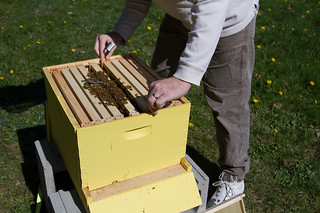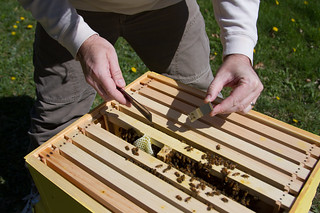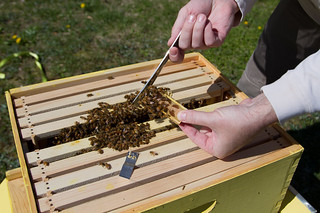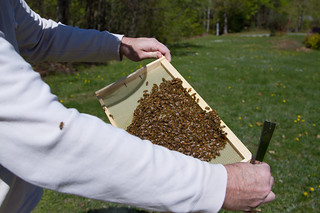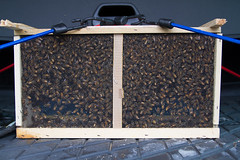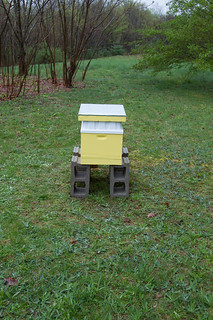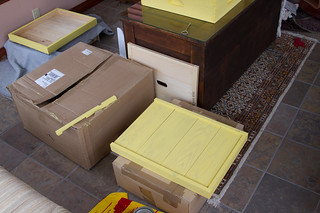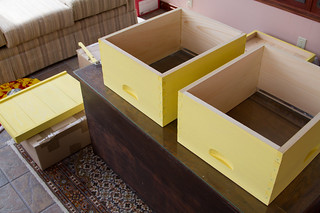In my
last post I described the hive setup and what I brought out to the “field” to install the bees.
It was an overcast afternoon in the mid-50s and a huge rainstorm that came up the east coast the day before was still causing sporadic showers, but fortunately nothing very heavy. So with the hive ready for the bees, I gathered up all the stuff described in my last post and took it out to the hive. Then went to the garage and grabbed the package and brought the bees out to the hive.
First thing, they are loud. Gave them a few sprays of sugar water and they quieted down some. Opened the hive, took out one frame and put in my plastic box I brought out with me, and took out four more frames and set them aside. Donned my veil, took a deep breath, and pried the cover off the package with the hive tool. Under the board is the feeding can. OK, yank that sucker out. A metal tab, which turned out to be holding the queen cage, fell right into the giant pile of bees. Pretty impressed with the buzzing mass of bees I was not about to reach down in there to retrieve whatever it was that fell.
Walked back to the house and got a can opener. Back at the hive I took the top off the can and it looks like that just contained sugar water to feed the bees. That makes sense. So where’s the queen? In the giant pile of bees, of course. Just do it you baby: reach down in there and get it. Good, the metal tab is sticking up. Got it. Ah!, there’s the cage I was expecting to find. I’m actually brushing bees off of this thing, and I’m not wearing gloves. My only attire is the veil (what the heck is this 40′ long cord for, anyway?), a white long-sleeve shirt, sneakers, and dungarees with strings tied around the ankles. But to these novice eyes, the queen looks perfectly healthy. There’s the little white paint on her back and she sure is scurrying around that little cage.
Focus. They seem louder, so I give them a little more spray. Gotta get that queen cage ready. Take out the pocket knife and start to take the cork stopper out of one end. Wait, where’s the candy that’s supposed to be under it? The queen’s going to walk out right now! Damn, there’s a cork on the other end too. I do my best to put the first cork back in the little hole, while watching bees out of the corner of my eye, wondering a little what the heck am I doing? Brush some bees off the cage and start digging the cork out of the other end. Good, the candy is under this one. Now, Ed Weiss, in his video, is all confidently and calmly standing there and at this point takes a small awl to put a hole in the candy for the bees to smell the queen’s pheromones. Even though I bought an awl just for this purpose I decided not to push my luck and didn’t touch the candy. I’ve been messing with this cage long enough.
I was able to get the metal tab reattached to the queen cage and then placed it between the 5th and 6th frames, then snuggle the 6th frame right up next to it, all the while thinking “I’m playing with bees, man!” The two hive nails that I bent at a 45° angle to hang the cage from wouldn’t push into the wood which is why I stuck with the metal tab; it seemed like I was taking hours for this simple operation.
Here we go: take the package and shake those babies right into the hive box. Don’t forget to pour some over the queen cage so they find that. Shake a little, pour some more, shake some more, pour, … this is truly a bizarre thing to be doing. I get as many bees into the hive as I can then set the package on the ground. So old Ed says now reach in and spread those babies around a little bit so that the other three frames can be put in on top of them.
Now I’m just standing there at this point, in utter amazement at what’s in front of me. This must be the part where I get stung. In I reach and push the pile to one side. That was incredible. They are all buzzing like crazy, there’s a strong strong smell of, well, bee, and the heat! The air temperature is in the mid-50s. You can feel the bee furnace—apparently the clump is always at like 80° or so—enclose your hand. This is too awesome, I’ve gotta do that again. Down goes the hand and spread the clump to the other side. Not one sting! I don’t want to press my luck so I pick up the other three frames and put them on top of the bees. I don’t think any are getting smushed.
Truly a memorable event. I will be doing this again, for sure.
 |
| The bees are home. The feeder is on top of the super and is full. |
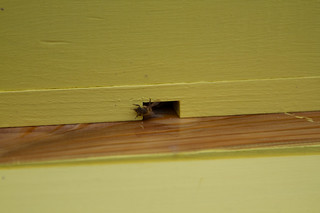 |
| Who goes there? |
After putting the 3 remaining frames into the super (I’m holding out the 10th until I remove the queen cage), I put the feeding box on top of the super and poured in the 5 pints of sugar water. Place the top cover and done!
Around 6:00 pm I went out and put the lashing strap around the hive and tightened it. Hopefully that will protect them some from any bear or dog attacks. Though if a bear knocks the hive over seems like the 5 pints will drown a lot of the bees. Oh well, we’ll see.
